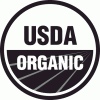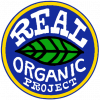
Answers to all of Your Organic Garlic Questions
Organic food is better for the environment, and better for you. Organic methods result in the use of fewer resources (such as water, synthetic fertilizer and fuel) and focus on preserving the health of the soil and the surrounding ecology. Instead of relying on synthetic fertilizer we employ methods including cover cropping and crop rotation. Instead of using herbicides to rid our field of weeds and cover crops prior to planting, we use silage tarps. Instead of turning over the soild every season (tilling) we use “no-til” methods which preserve and encourages the growth of the soil’s natural biologics, worms and beneficial insects and retains air voids.
 Yes. We completed a rigorous 9-month process to develop an organic farm plan, educate ourselves and complete the application process to ensure that our farm meets and can maintain the USDA’s standards for using the label ‘organically grown.’ Our certifier in 2021/ 2022 is the Rhode Island Department of Environmental Management (DEM). The DEM is not just our certifier, but also our partner, providing expert counsel as we continue to grow and incorporate new methods.
Yes. We completed a rigorous 9-month process to develop an organic farm plan, educate ourselves and complete the application process to ensure that our farm meets and can maintain the USDA’s standards for using the label ‘organically grown.’ Our certifier in 2021/ 2022 is the Rhode Island Department of Environmental Management (DEM). The DEM is not just our certifier, but also our partner, providing expert counsel as we continue to grow and incorporate new methods.
There are hundreds of varieties of garlic. The two main categories are “hardneck” and “softneck.” Hardneck garlic grows a long stem called a “scape” which is both edible and delicious. Besides serving as an enjoyable snack for humans, the purpose of the scape is reproduction. The scape, if left to fully develop, will turn into a flower – actually many (20-50+) flowers that are each attached to a tiny garlic seed called a “bobule.” If planted, the bobule will crow into a single clove, and the next year can be planted and will produce a full bulb the following year. Hardneck garlic is best grown in cold regions, which is why it is typically grown in the Northeast states like Rhode Island.
Softneck garlic lacks the scape and only some varieties grown in colder areas. Most garlic found in the store is softneck. One advantage of softneck garlic is that it is easier to mass produce, as it can be easily planted mechanically. Why? it can be planted in any direction, whereas hardneck garlic must be planted with the pointy-end facing up. For this reason, most garlic farms in the Northeast are small – 1-3 acres in size.
If properly stored (cool, dry), garlic can be properly stored for several months.
Yes! Sortof. It is easy to grown on a small scale because it is quite hearty and will thrive in a wide range of soil conditions. You can plant our seed garlic in your garden or in planters. Growing commercially takes a lot more work.
Start with organic bulbs, if you can, to be sure it has not been treated with chemicals that may keep it from sprouting. In your garden, make a trench 3-5 inches deep and plant the individual cloves about 6-8 inches apart, in rows about 8-12 inches apart. Cover the cloves (which must be pointed up for hardneck varieties) with about 2-4 inches of soil.
Planting time depends on your location. In Rhode Island, garlic should be planted between October 15-October 31 (+/-). Cover with a bit of mulch (straw) if you want, but its not really necessary.
In the spring, you can think your garlic, if you want, and enjoy early season “green garlic.” In late June scapes will mature and a few weeks later your garlic will be ready to harvest!
Any organic garlic clove can be reliably planted. The biggest cloves will yield the largest bulbs, so when you see the term “see garlic” it typically just means the bulbs are bigger. Saunderstown Garlic Farm garlic bulbs are usually 2-inches in diameter or larger.
Green garlic will be available in late May/ early June. Scapes available in late June and garlic will be ready to order by the beginning of August (it needs a few weeks to dry). Because this will be our first season with enough garlic to sell, and because we are not certain what our yield will be, we will probably not be taking pre-orders.
You can find Saunderstown Garlic Farm garlic in a few places: (1) What’s Good – a farmstand app started by entrepreneurs in Rhode Island; (2) Our farmstand at 290 Snuff Mill Road (check our markets page before heading over to be sure we are open); (3) This website; (4) At local farmer’s markets and possibly local grocers (TBD).



